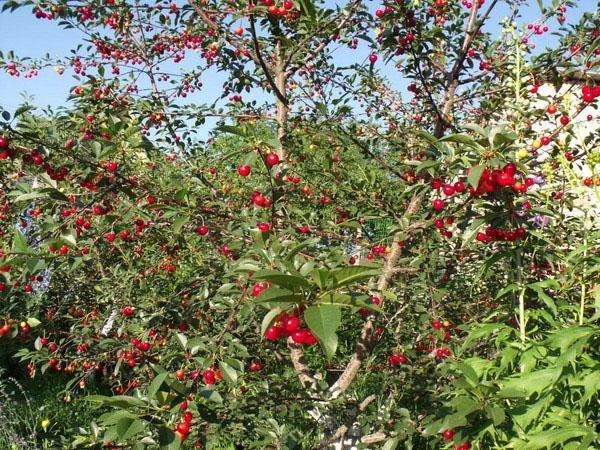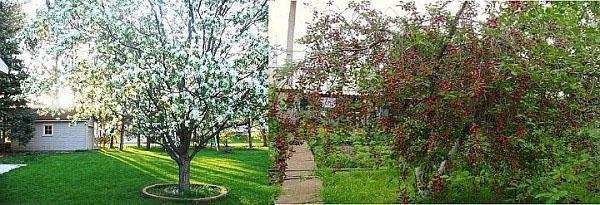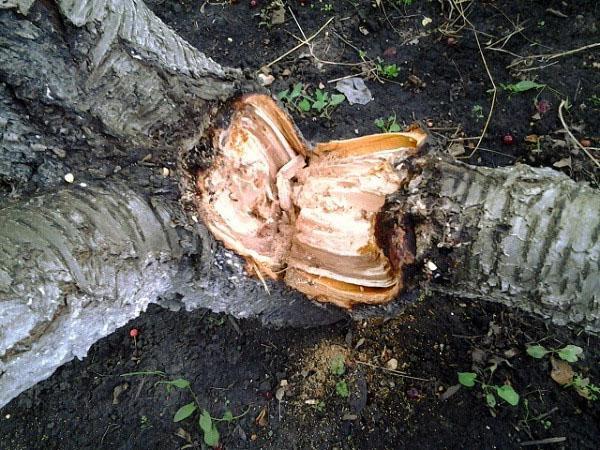Find a spot on your plot for a hybrid Spunk cherry
 If you are not trying to harvest a decent cherry crop as soon as possible, you should try growing the Shpanka cherry variety in the garden. This cherry appeared thanks to Ukrainian folk selection as a result of crossing cherries and cherries, therefore, in the description of the Shpanka cherry variety and in the photo, there are common signs of both. Most often, Shpanku can be found in Ukrainian gardens, but the variety has also gained recognition in Russia and Moldova.
If you are not trying to harvest a decent cherry crop as soon as possible, you should try growing the Shpanka cherry variety in the garden. This cherry appeared thanks to Ukrainian folk selection as a result of crossing cherries and cherries, therefore, in the description of the Shpanka cherry variety and in the photo, there are common signs of both. Most often, Shpanku can be found in Ukrainian gardens, but the variety has also gained recognition in Russia and Moldova.
Description of the Shpanka cherry variety, photos of its subspecies


The leaves of the hybrid (unlike the usual cherry) are pointed, rather long, like a cherry, grow up to 8 cm in length. They have a rolling double coloring: from the green base to the dark green top of the leaf. The petioles themselves are pink. During the flowering period, the cherry throws out inflorescences with 2-3 large flowers of five petals each.
Shpanki berries are quite large, up to 5 grams, burgundy shiny color, there are also brown tints. As you can see in the photographs with a description of the Shpanka cherry variety, they are more reminiscent of sweet cherries in shape - slightly flattened, 1 cm in diameter, in the middle there is an almost imperceptible groove. The pulp of the fruit, yellow and juicy, is also similar to a cherry - the same dense, homogeneous structure that you cannot find in cherries. Accordingly, the juice from such cherries does not have a rich red color. But, on cancellation from cherries, a small stone leaves the berry well.
Fruit ripening is uneven, occurs in June-early July. The arrangement of cherries of this variety is akin to sweet cherries - for the entire length of a one-year shoot, or a dense garland surround a branch. For this reason, the shoots need to be pruned periodically. But unlike cherries, the attachment to the branch of the berries is fragile, therefore ripe cherries often crumble (see. chocolate cherry variety) .
 The Shpanka cherry variety bears abundantly only from the 6th year of life. However, on the rootstocks, a small amount of the first berries can be harvested in the third year of the seedling's life. With each subsequent year, the amount of harvest increases, and after 15 years, up to 50 kg of berries are removed from one tree.
The Shpanka cherry variety bears abundantly only from the 6th year of life. However, on the rootstocks, a small amount of the first berries can be harvested in the third year of the seedling's life. With each subsequent year, the amount of harvest increases, and after 15 years, up to 50 kg of berries are removed from one tree.
The variety does not tolerate transportation well, so it is better to use it immediately for making jam, compotes, wine, jam, or in cooking.
Cherry Shpanka has several subspecies, photos of which are provided below:
- Dwarf spank (no more than 3 meters high).

- Shpanka Bryansk (medium height from 3 to 4 meters).

- Shpanka Kursk (4 meters).

- Shpanka Shimskaya (medium-sized frost-resistant variety for the northern regions).

- Donetsk spank (early ripening hybrid of cherries Valery Chkalov and Donchanka cherries).

- Large-fruited spank.

- Early spank (harvest in early summer).

Despite the fact that Shpanka is considered a self-fertile variety, it needs additional pollinators. They are others cherry varieties and cherries. The Shpanki cherry Griot Ostheimsky, the Persistent cherry has a good effect on the yield.
 The Shpanka variety perfectly tolerates both dry summers and severe frosts, and is also resistant to coccomycosis.For active growth and fruiting, the variety needs light and nutritious soil. If the soil is poor in useful elements, the tree will begin to "cry" - burn marks and inclusions similar to resin will appear on the main trunk and side branches.
The Shpanka variety perfectly tolerates both dry summers and severe frosts, and is also resistant to coccomycosis.For active growth and fruiting, the variety needs light and nutritious soil. If the soil is poor in useful elements, the tree will begin to "cry" - burn marks and inclusions similar to resin will appear on the main trunk and side branches.
Features of planting seedlings
 Cherry Shpanka has its own characteristics of planting and care. As for planting, the most suitable place for planting a seedling will be a sunny place near the fence - it will protect the cherry from harmful gusts of wind. It is even better if it is a hill, especially when there is a close presence of groundwater. In the case of planting a whole garden, a distance of 4 meters must be left between the seedlings.
Cherry Shpanka has its own characteristics of planting and care. As for planting, the most suitable place for planting a seedling will be a sunny place near the fence - it will protect the cherry from harmful gusts of wind. It is even better if it is a hill, especially when there is a close presence of groundwater. In the case of planting a whole garden, a distance of 4 meters must be left between the seedlings.
As already mentioned, the Shpanka cherry variety loves loose, nutritious soil. With increased acidity of the soil, lime must be added at the rate:
- for sandy loam lands - 500 g per 1 sq.m .;
- for heavy loamy - 800 g per 1 sq.m.
In the presence of heavy clay soil, sand is added to it.
In order not to burn the roots of the seedling, when lime is introduced into the soil, it is well rubbed with the ground.
Autumn planting (September) is more suitable for the southern regions, but in the east it is better to plant Shpanku in spring. When planting cherries in the fall, a hole is dug and fertilized two weeks before planting. A feature of spring planting is that the planting hole (50x100 cm in size) should be prepared in the fall. The soil from the pit is mixed with fertilizers. For one seedling (that is, for one planting hole), it is recommended to apply the following proportions of fertilizers:
- 1 bucket of humus;
- 500 g of reverse ash;
- 200 g superphosphate;
- 100 g of potassium fertilizer.
Cherry seedlings should be inspected for damage before planting. If there are broken roots, they need to be cut off. If dry roots are detected, it is recommended to put the seedling in warm water, to which add a little honey.
Water the planted tree with warm water (3 buckets), while paying attention to the location of the root collar. According to the planting rules, it should be on a level with the ground.
Cherry care steps: watering, feeding, pruning
 Despite the fact that the variety is drought-resistant, the cherry must be watered abundantly during the growing season. The first time - during flowering (April-May), the second - during the ripening of berries (second decade of June). If you do not pour two or three buckets of water under each seedling during these periods, the fruits may change their taste. To prevent moisture loss, cover the soil around the seedling with compost or sawdust. Periodically loosen the ground under the tree and clean it of weeds.
Despite the fact that the variety is drought-resistant, the cherry must be watered abundantly during the growing season. The first time - during flowering (April-May), the second - during the ripening of berries (second decade of June). If you do not pour two or three buckets of water under each seedling during these periods, the fruits may change their taste. To prevent moisture loss, cover the soil around the seedling with compost or sawdust. Periodically loosen the ground under the tree and clean it of weeds.
In the spring the tree is fed nitrogen fertilizers, Bordeaux acid, and in the fall - potassium and phosphorus. In the conditions of a prolonged and cold spring, gardeners who practice folk fertilization methods are advised to spray the cherries with a solution of boiled water and honey. A similar solution is used to attract insects during the flowering period. In general, the tree must be fertilized three times during the year: twice during the growing season and once in the fall when digging.
In autumn, you also need to prepare the cherry for wintering: remove leaves and grass under the tree, dig up, whitewash the trunk. For whitewashing, add laundry soap and copper sulfate to the lime. When snow appears, fill the trunk circle with it, stamp it well, cover it with sawdust on top. Such manipulations will allow you to delay the beginning of flowering and prevent the death of inflorescences from spring frosts.
 So that the crown of the cherry does not become thick over time, and the branches do not break under the harvest, it is periodically cleaned. The first branches begin to dry out approximately 7 years after planting the tree.
So that the crown of the cherry does not become thick over time, and the branches do not break under the harvest, it is periodically cleaned. The first branches begin to dry out approximately 7 years after planting the tree.